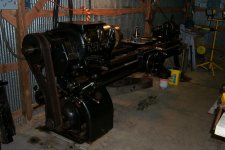If this machine is in pretty good shape, you'll be amazed at what it is capable of. I have a nearly identical one. Curious what part of Georgia you are in, as mine also came from Georgia, same exact machine with only a few differences (motor in leg, taper attach and no chip pan, although that one looks shop made). Mine came from Franklin, GA, southwest of Atlanta, just a few miles from Newnan.
All those handles are indeed original, so it hasn't been too severely abused. That bent handle is easily straightened with a little patience and heat. Clamp the center boss in a vise and gently heat with a torch until it is a nice medium red, and then gently pull up with a crescent wrench or other form of leverage. Use your fingertips to avoid over loading and breaking and keep your heat on the side of the bend that is compressing. If you heat the side that is stretching it will crack.
As for leaks, the very act of moving it will cause it to leak. There are no "seals" in this machine. What you have are labyrinth seals, slingers and drains that deflect oil back into the headstock and clutch case. These work primarily on centrifugla force, which slings the oil outward and redirect it towards the drains that lead back to the headstock and clutch case. If you get the oil level above those labyrinth seals, there is NOTHING to keep the oil from running out. When you tilted the wrecker bed to load and unload, the oil level went over the seal and it probably leaked pretty good. When the truck accelerated or braked, the oil sloshed. It is probably drooling from both ends of the spindle and from the clutch pulley.
Now, all that said, this machine will ALWAYS leak oil. These are not lip seals, so a little oil seeps by, no matter what. It is normal. Just keep some oil soak in the pan. The oil leaks because there is no pump, so that is how the oil circulates and is changed. All lubrication except the headstock and clutch oil is total loss. It runs through and on the floor. That's just how things were done. Don't be tempted toput grease fittings anywhere there are oil ports or fittings, that just clogs up the bearing and ruins it.
There are about five hundred oil ports on that machine that need to be kept oiled during operation. Find them ALL. Right off the top of my head, two on either end of the headstock for the QC shafts. That's two holes in the casting and two upturned tubes. One in the QC lever itself, one in the clutch rod bearing, a couple in the clutch actuator rod swivels, two in the leadscrew shaft bearings, a couple on the left hand end of the 4speed range box on the leadscrew, one on the leadscrew reverse lever in the headstock gearing cover, at least two holes in the leadscrew gearing axles (inside the round cover), one on the front left carriage wing right over the way, flathead set screw plug you remove to oil the apron internals. One on the carriage traverse handwheel boss, one on each of the feed star wheel bosses, one on the fwd-neu-rev tumbler lever, one on the half nut lever, one on the clutch lever boss. 4 ball oilers on the carriage wings, two bottle shaped oilers on the front of the carriage where it rides the tailstock way, one on the crossfeed gear, right under the crossfeed screw, one in the crossfeed micrometer barrel, another flathead setscrew, one on the crossfeed nut and at the other end, one on the compound leadscrew bearing and another halfway up for the screw (crank the crossfeed all the way in to oil that), and one in the side of the thread dial. One on the tailstock barrel, one on the screw bearing and finally, one each on the clutch and leadscrew outboard bearings. I may have missed one or two. Use a thin piece of stainless cable or thin welding wire and run every one of those open oil holes to clear dirt dobbers. Nearly every one on mine was packed.
Any questions, I can assure you I have been there and done that with the EXACT same machine...














